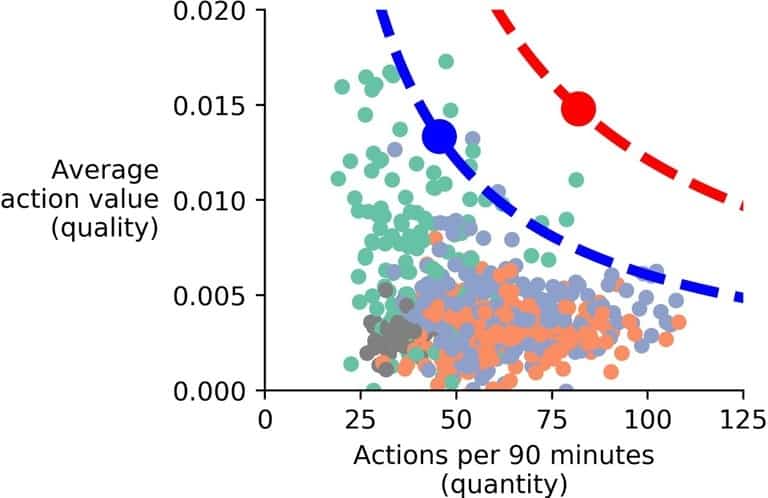
Researchers at KU Leuven and data intelligence company SciSports have developed a new algorithm to assess football players’ on-the-ball actions. Their model goes beyond traditional player statistics like the number of goals and assists, offering a more complete assessment of a player’s performance and contribution to his team.
By Bregt Van Hoeyveld, KU Leuven
For more than a decade, Cristiano Ronaldo and Lionel Messi have been the dominant forces in international football. Both have a strong claim to the title of the Greatest of All Time, or GOAT: both players have an amazing track record; they’ve each scored more than 600 goals for their club and country, and both are five-time winners of the Ballon d’Or. On paper, therefore, it’s impossible to identify the one and only GOAT. But a new model developed in Belgium and the Netherlands may have the solution.
Researchers from KU Leuven and data intelligence company SciSports (Enschede, the Netherlands) have developed an algorithm to value a player’s impact on the game. “Football players are often judged solely on their goals and assists,” says Professor Davis from the Department of Computer Science at KU Leuven. “But the number of goals is not the best parameter if you consider that on average, there are 1,600 actions in each game. That’s why our computer model takes into account all on-the-ball actions: shots, passes, dribbles, tackles, everything.”
The model generates a rating called VAEP (Valuing Actions by Estimating Probabilities). This rating indicates how a specific player’s actions contribute to the game score – offensively (scoring goals) as well as defensively (preventing goals from the opposition). This way, you can evaluate a player’s performance and his contribution to the team in greater detail.
So, what can this novel method contribute to the Messi-Ronaldo debate? The researchers examined several seasons of the Spanish La Liga (from 2013-14 until 2017-18) and compared both players’ performances. The results indicate that in recent years, Lionel Messi had the advantage over his rival.

This graph represents all players in the English and Spanish leagues during the 2017-2018 season. Lionel Messi (red) is the clear outlier with a VAEP rating of 1.21 per game. Ronaldo (blue) records a considerably lower score of 0.61.
“In the first seasons, the ratings of Ronaldo and Messi are very similar,” explains PhD student Tom Decroos from KU Leuven. “But since the 2015-2016 season, the Argentinian striker has the edge. Traditionally you find a trade-off between the quality and quantity of the actions. Players like Kevin De Bruyne and Paul Pogba perform a large number of actions but with a lower average value per action. Other players perform fewer actions, but with a bigger impact. This is typically the case for strikers such as Harry Kane, Mohamed Salah, and Cristiano Ronaldo. In this respect, Lionel Messi is a true outlier: the Argentinian performs a large number of actions with a high value.”
What about the new kids in town?
In the meantime, there have been some changes at Real Madrid: all-time top scorer Cristiano Ronaldo has joined Juventus in the Italian Serie A and Eden Hazard was brought in as his replacement. The VAEP framework suggests that the Belgian player could be a worthy successor. Based on their performances in the 2017-2018 season – Ronaldo’s final season for Madrid – both players seem evenly matched. Hazard, playing for Chelsea at the time, recorded a VAEP rating of 0.64 per game: this indicates that his actions contribute 0.64 goals more than the opposing team. Ronaldo’s rating for that season was just a fraction lower: 0.61 per game.
“Although their ratings are very similar, we’ve also noticed some obvious differences,” says Lotte Bransen, scientific researcher at SciSports. “Ronaldo stands out because of his finishing skills. His VAEP rating is highly dependent on the quality of his shots and to a lesser extent of his dribbles. Eden Hazard, on the other hand, is more involved with the team play: his rating is more evenly distributed across shots, dribbles, and passes. If Real Madrid wants to get the best out of Eden Hazard, they will have to adjust their playing style.”
Frenkie de Jong
Real Madrid’s rival FC Barcelona have acquired the services of Frenkie De Jong. The Dutch midfielder arrives at the Nou Camp as a very promising prospect, and rightly so according to Bransen. “Our research points out that De Jong has been highly influential for Ajax during the previous season. In the Dutch league, he was the midfielder with the highest rating for passes and dribbles. In terms of playing style and qualities, De Jong seems a perfect fit to replace club legend Andres Iniesta.”
(Continue below the video)
Useful for scouting
One of the main purposes of the VAEP framework is to identify promising talents, says Jan Van Haaren, head of Data & Analytics at SciSports. “Our company tracks a hundred thousand players around the world. Not all of them stand out in terms of goals and assists. This model allows us to evaluate their performances in more detail and assess their true potential. In recent years, data analytics have become increasingly important for scouting and player acquisition.”
The model already offers various possibilities, but there’s still room for improvement, acknowledges Tom Decroos (KU Leuven). “At the moment, we can only evaluate actions on the ball. Other types of actions which can be equally important – the way an attacker uses space or how a defender positions himself – cannot be assessed. If we get access to more data, our model will improve even further.”
The final GOAT
The results suggest that Lionel Messi has a better claim to the title of GOAT, but is it the entire picture? The researchers only examined the national leagues and didn’t take into account other cups or tournaments. Furthermore, it’s fair to say that in recent years Cristiano Ronaldo has truly excelled at the European level. In six seasons Real Madrid has won the Champions League four times, and Ronaldo played a pivotal role in those victories. So who is truly the Greatest of All Time? The debate may not be over after all.
The research was presented at the KDD conference in Alaska and won the Best Paper Award for applied data science. “This conference is highly acclaimed in the field of data mining,” Professor Jesse Davis reacts. “Even the biggest tech companies such as Apple, Google, and Microsoft submit papers to this conference. The fact that our research was selected out of seven hundred submissions shows that our VAEP framework has great potential.”





